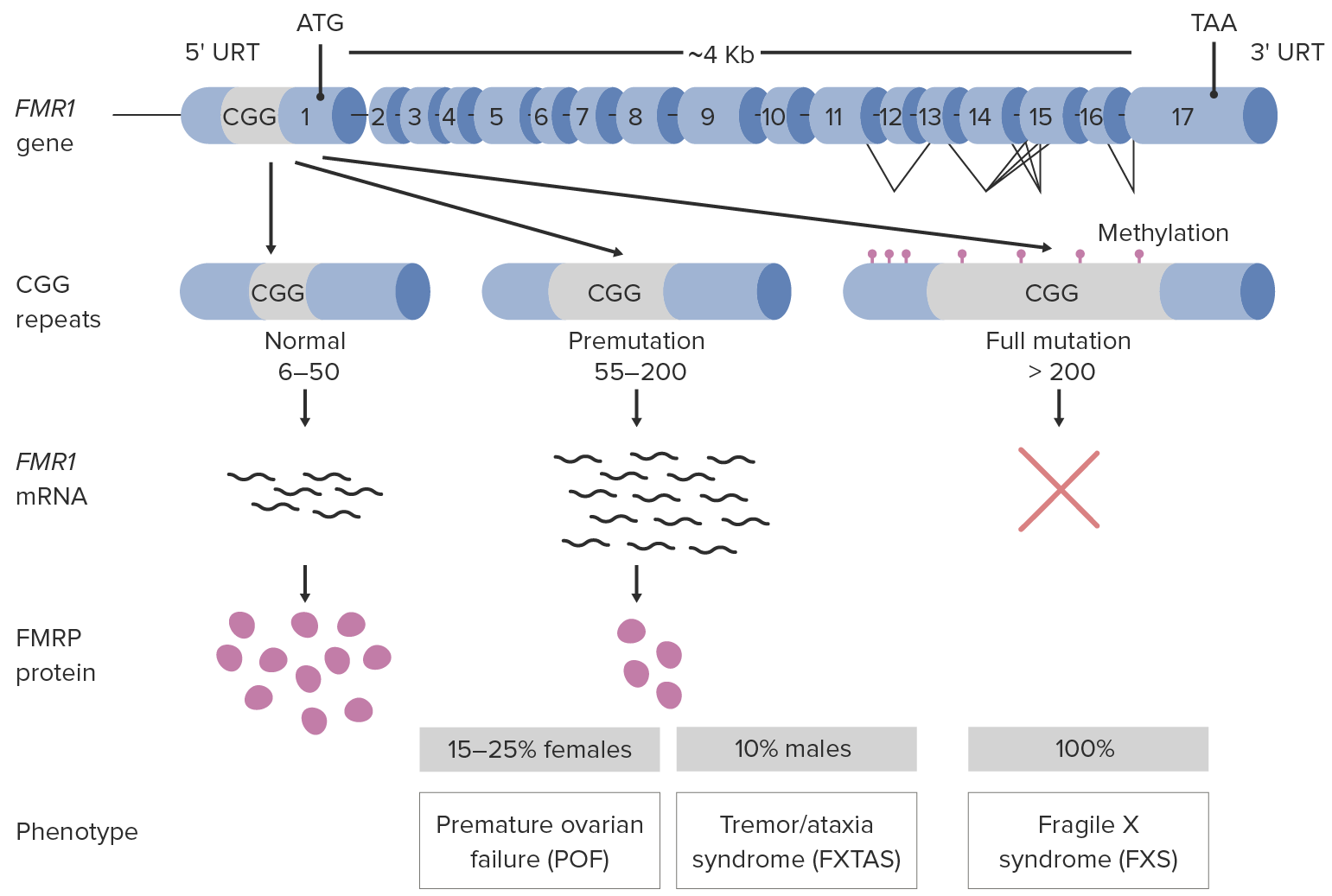Playlist
Show Playlist
Hide Playlist
Fragile X Syndrome: CGG Expanding Repeat
-
Slides 03 Expansions and Mitochondrial Inheritance SingleGeneDisorders.pdf
-
Download Lecture Overview
00:01 Then we’ll consider the other disorder that’s an expanding trinucleotide repeat as Fragile X syndrome. 00:08 You’ll recall that I have discussed Fragile X previously. What sort of inheritance pattern does Fragile X have? Well, that’s right. If you've said X-linked dominant inheritance pattern then you nailed it. 00:26 You’re remembering things really well. Fragile X syndrome is a syndrome in witch we see a fragile region, on the X chromosome. In general, it causes some moderate intellectual disability. 00:39 Fragile X syndrome is the most common inherited cause of intellectual disability. 00:45 Affected children often show autistic behaviors and may have comorbid autism; however, autism alone will not have the clinical features of fragile X syndrome. 00:58 There is a fragile site that we see because of extra cytosine methylation. Recall that methylation occurs on cytosine residues in the DNA. Because it’s extra methylated, it doesn’t condense properly. 01:18 So, not only do we have this fragile region but also the methylation doesn’t come off when DNA unwinds. 01:28 So, we’ll see gene silencing. Gene silencing meaning the genes in that region aren’t actually expressed not only because that region actually falls off more easily anyway but we do see that the genes in that region are not expressed. This expanding repeat is much larger than Huntington’s repeat. Any individual in the normal range would be less than 50 but a premutation can be up to 200 repeats. We have a relatively high frequency of premutations. The reason I highlight that it’s 1 in 200 females is because it’s really only known to expand when it’s passed from a female. It’s opposite than we saw in Huntington’s, right? In this figure over here, you can see the number of repeats along the X axis and how frequently that will expand from a premutation into a full mutation. You can see obviously the more repeats there are, the more likely it is to expand into a full mutation. One in two hundred females carry it. Males can also carry it. 02:55 But it’s much less likely that we will see the expansion from a premutation. Only really females can pass on from a premutation. Anyway, affected individuals can have more than 200 up to thousands of repeats in this. 03:15 So it’s a much larger expanding repeat than we see in Huntington’s disease and sort of a female biased expansion or attenuation.
About the Lecture
The lecture Fragile X Syndrome: CGG Expanding Repeat by Georgina Cornwall, PhD is from the course Single-Gene Disorders.
Included Quiz Questions
What is the excessive trinucleotide repeat in fragile X syndrome?
- Cytosine-guanine-guanine
- Cytosine-adenine-guanine
- Cytosine-thymine-guanine
- Guanine-adenine-adenine
- Adenine-thymine-guanine
Which of the following best describes fragile X syndrome?
- The most common cause of inherited intellectual disability.
- The most common autosomal bleeding disorder.
- The most common cause of inherited lysosomal storage disease.
- The most common cause of fattty acid metabolism disruption.
- The most common cause of sex-linked colorblindness.
How does the excessive trinucleotide repeat in fragile X syndrome affect gene expression?
- It causes methylation and gene silencing.
- It causes methylation and gene transcription.
- It causes adenylation and gene silencing.
- It causes adenylation and gene transcription.
- It does not affect gene expression.
Customer reviews
5,0 of 5 stars
| 5 Stars |
|
1 |
| 4 Stars |
|
0 |
| 3 Stars |
|
0 |
| 2 Stars |
|
0 |
| 1 Star |
|
0 |
It helps me a lot with my presentation, I was having a hard time understanding this topic and after see this lecture it becomes easy to explain. Thank you so much.




